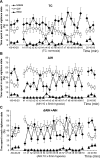Diaphragm long-term facilitation following acute intermittent hypoxia during wakefulness and sleep
- PMID: 21372099
- PMCID: PMC3098661
- DOI: 10.1152/japplphysiol.00055.2011
Diaphragm long-term facilitation following acute intermittent hypoxia during wakefulness and sleep
Abstract
Acute intermittent hypoxia (AIH) elicits a form of respiratory plasticity known as long-term facilitation (LTF). Here, we tested four hypotheses in unanesthetized, spontaneously breathing rats using radiotelemetry for EEG and diaphragm electromyography (Dia EMG) activity: 1) AIH induces LTF in Dia EMG activity; 2) diaphragm LTF (Dia LTF) is more robust during sleep vs. wakefulness; 3) AIH (or repetitive AIH) disrupts natural sleep-wake architecture; and 4) preconditioning with daily AIH (dAIH) for 7 days enhances Dia LTF. Sleep-wake states and Dia EMG were monitored before (60 min), during, and after (60 min) AIH (10, 5-min hypoxic episodes, 5-min normoxic intervals; n = 9), time control (continuous normoxia, n = 8), and AIH following dAIH preconditioning for 7 days (n = 7). Dia EMG activities during quiet wakefulness (QW), rapid eye movement (REM), and non-REM (NREM) sleep were analyzed and normalized to pre-AIH values in the same state. During NREM sleep, diaphragm amplitude (25.1 ± 4.6%), frequency (16.4 ± 4.7%), and minute diaphragm activity (amplitude × frequency; 45.2 ± 6.6%) increased above baseline 0-60 min post-AIH (all P < 0.05). This Dia LTF was less robust during QW and insignificant during REM sleep. dAIH preconditioning had no effect on LTF (P > 0.05). We conclude that 1) AIH induces Dia LTF during NREM sleep and wakefulness; 2) Dia LTF is greater in NREM sleep vs. QW and is abolished during REM sleep; 3) AIH and repetitive AIH disrupt natural sleep patterns; and 4) Dia LTF is unaffected by dAIH. The capacity for plasticity in spinal pump muscles during sleep and wakefulness suggests an important role in the neural control of breathing.
Figures







Similar articles
-
Adenosine 2A receptor inhibition enhances intermittent hypoxia-induced diaphragm but not intercostal long-term facilitation.J Neurotrauma. 2014 Dec 15;31(24):1975-84. doi: 10.1089/neu.2014.3393. Epub 2014 Sep 26. J Neurotrauma. 2014. PMID: 25003645 Free PMC article.
-
Daily acute intermittent hypoxia elicits functional recovery of diaphragm and inspiratory intercostal muscle activity after acute cervical spinal injury.Exp Neurol. 2015 Apr;266:1-10. doi: 10.1016/j.expneurol.2015.02.007. Epub 2015 Feb 14. Exp Neurol. 2015. PMID: 25687551 Free PMC article.
-
Sleep state dependence of ventilatory long-term facilitation following acute intermittent hypoxia in Lewis rats.J Appl Physiol (1985). 2010 Aug;109(2):323-31. doi: 10.1152/japplphysiol.90778.2008. Epub 2010 Apr 1. J Appl Physiol (1985). 2010. PMID: 20360430 Free PMC article.
-
Acute intermittent hypoxia induced neural plasticity in respiratory motor control.Clin Exp Pharmacol Physiol. 2013 Sep;40(9):602-9. doi: 10.1111/1440-1681.12129. Clin Exp Pharmacol Physiol. 2013. PMID: 23781949 Review.
-
Is there a link between intermittent hypoxia-induced respiratory plasticity and obstructive sleep apnoea?Exp Physiol. 2007 Jan;92(1):27-37. doi: 10.1113/expphysiol.2006.033720. Epub 2006 Nov 10. Exp Physiol. 2007. PMID: 17099064 Review.
Cited by
-
Effect of acute intermittent hypoxia on cortico-diaphragmatic conduction in healthy humans.Exp Neurol. 2021 May;339:113651. doi: 10.1016/j.expneurol.2021.113651. Epub 2021 Feb 16. Exp Neurol. 2021. PMID: 33607080 Free PMC article.
-
Obesity accentuates circadian variability in breathing during sleep in mice but does not predispose to apnea.J Appl Physiol (1985). 2013 Aug 15;115(4):474-82. doi: 10.1152/japplphysiol.00330.2013. Epub 2013 May 30. J Appl Physiol (1985). 2013. PMID: 23722707 Free PMC article.
-
Effect of acute intermittent hypoxia treatment on ventilatory load compensation and magnitude estimation of inspiratory resistive loads in an individual with chronic incomplete cervical spinal cord injury.J Spinal Cord Med. 2016;39(1):103-10. doi: 10.1179/2045772314Y.0000000277. Epub 2014 Nov 15. J Spinal Cord Med. 2016. PMID: 25400130 Free PMC article. Review.
-
Dose-dependent phosphorylation of endogenous Tau by intermittent hypoxia in rat brain.J Appl Physiol (1985). 2022 Sep 1;133(3):561-571. doi: 10.1152/japplphysiol.00332.2022. Epub 2022 Jul 21. J Appl Physiol (1985). 2022. PMID: 35861520 Free PMC article.
-
Impact of repeated daily exposure to intermittent hypoxia and mild sustained hypercapnia on apnea severity.J Appl Physiol (1985). 2012 Feb;112(3):367-77. doi: 10.1152/japplphysiol.00702.2011. Epub 2011 Nov 3. J Appl Physiol (1985). 2012. PMID: 22052874 Free PMC article.
References
-
- Aboubakr SE, Taylor A, Ford R, Siddiqi S, Badr MS. Long-term facilitation in obstructive sleep apnea patients during NREM sleep. J Appl Physiol 91: 2751–2757, 2001. - PubMed
-
- Babcock M, Shkoukani M, Aboubakr SE, Badr MS. Determinants of long-term facilitation in humans during NREM sleep. J Appl Physiol 94: 53–59, 2003. - PubMed
-
- Babcock MA, Badr MS. Long-term facilitation of ventilation in humans during NREM sleep. Sleep 21: 709–716, 1998. - PubMed
-
- Baker-Herman TL, Fuller DD, Bavis RW, Zabka AG, Golder FJ, Doperalski NJ, Johnson RA, Watters JJ, Mitchell GS. BDNF is necessary and sufficient for spinal respiratory plasticity following intermittent hypoxia. Nat Neurosci 7: 48–55, 2004. - PubMed
Publication types
MeSH terms
Grants and funding
LinkOut - more resources
Full Text Sources
Miscellaneous

